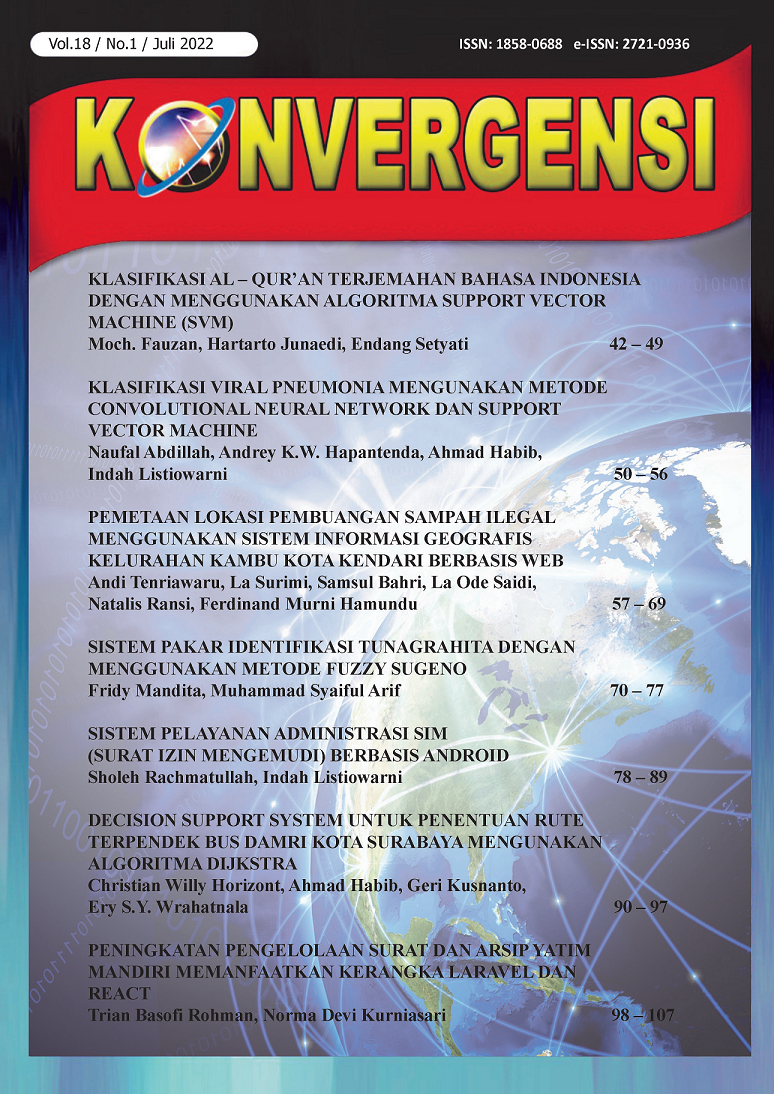KLASIFIKASI VIRAL PNEUMONIA MENGUNAKAN METODE CONVOLUTIONAL NEURAL NETWORK DAN SUPPORT VECTOR MACHINE
Abstract
Cases of Corona Virus Disease 2019 (Covid-19) have been found in Indonesia since March 2019, for diagnosis in addition to the Real Time - Polymerase Chain Reaction (RT-PCR) examination, a Thorax X-ray is also carried out to detect the presence of Pneumonia. Pneumonia is an inflammation of the air sacs in the lungs that can fill with fluid. Pneumonia can be caused by a bacterial, viral or fungal infection. The proposed method combines the CNN method with SVM for the classification of viral Pneumonia with bacterial Pneumonia. The results of this study are expected to help radiology officers in classifying Pneumonia caused by viruses from the results of Thorax X-rays. The performance of this system is measured using confusion matrix and produces a score of average accuracy 0.85.
Keywords: Convolutional Neural Network, Covid-19, Support vector Machine, Viral Pneumonia.
ABSTRAK
Kasus Corona Virus Disease 2019 (Covid-19) ditemukan di Indonesia sejak Maret 2019, untuk penegakan diagnose selain pemeriksaan Real Time – Polymerase Chain Reaction (RT-PCR) juga dilakukan pemeriksaan Rontgen Thorax untuk mendeteksi adanya Pneumonia. Pneumonia merupakan peradangan pada kantung udara pada paru-paru yang dapat berisi cairan. Penyebab Pneumonia bisa berasal dari infeksi bakteri,virus ataupun jamur. Metode yang diusulkan menggabungkan metode CNN dengan SVM untuk klasifikasi Pneumonia virus dengan Pneumonia bakteri. Hasil dari penelitiasn ini diharapkan dapat membantu petugas radiologi dalam mengklasifikasikan Pneumonia yang disebabkan oleh virus dari hasil Rontgen Thorax. Performa sistem ini diukur menggunakan confusion matrix dan menghasilkan skor akurasi rata-rata sebesar 0.85.
Kata Kunci: Convolutional Neural Network, Covid-19, Support Vector Machine, Viral Pneumonia
Downloads
References
M. Suyuti and E. Setyati, “Pneumonia Classification of Thorax Images using Convolutional Neural Networks,” Jurnal INFORM, vol. 5, no. 2, p. 62, 2020.
J. Estomihi, “Klasifikasi Penyakit Pneumonia Dari Citra X-Ray Menggunakan Backpropagation,” pp. 1–74, 2019.
N. Singh, “Wavelet Transform Based Pneumonia Classification of Chest X- Ray Images,” in Int. Conf. Comput. Power Commun. Technol, 2019, pp. 540–545.
A. Sharma, D. Raju, and S. Ranjan, “Detection of pneumonia clouds in chest X-ray using image processing approach,” in Nirma Univ. Int. Conf. Eng. NUiCONE, 2018, pp. 1–4.
A. F. Agarap, “An Architecture Combining Convolutional Neural Network (CNN) and Support Vector Machine (SVM) for Image Classification,” pp. 5–8, 2017.
S. Albawi, T. . Mohammed, and S. Al-Zawi, “Understanding of a convolutional neural network,” in Int. Conf. Eng. Technol. ICET 2017, 2018, pp. 1–6.
R. Poojary and A. Pai, “Comparative Study of Model Optimization Techniques in Fine-Tuned CNN Models,” in International Conference on Electrical and Computing Technologies and Applications (ICECTA), 2019, pp. 1–4.
J. Irvin et al., “CheXpert: A large chest radiograph dataset with uncertainty labels and expert comparison,” 33rd AAAI Conference on Artificial Intelligence, AAAI 2019, 31st Innovative Applications of Artificial Intelligence Conference, IAAI 2019 and the 9th AAAI Symposium on Educational Advances in Artificial Intelligence, EAAI 2019, pp. 590–597, 2019.
A. Hapantenda and F. X. Ferdinandus, “Sistem Otomatis Untuk Cropping Region of Interest Sel Darah Putih Pada Citra Leukemia Limfoblast Akut,” 2017.
A. K. W. Hapantenda, F. X. Ferdinandus, and R. A. Harianto, “Deteksi Jumlah Leukosit Bersentuhan Pada Citra Mikroskopis Leukemia Limfoblastik Akut Menggunakan Multiple K-Means Clustering,” Seminar Nasional Aplikasi Teknologi Informasi (SNATI), pp. 57–62, 2018.
A. K. W. Hapantenda, A. Januantoro, and I. Listiowarni, “Studi Independen Komparasi Segmentasi Sel darah Putih Menggunakan Ruang Warna HSV Dengan CIE-L*a*b,” Konvergensi, vol. 15, no. 2, pp. 97–104, 2019.
A. Januantoro, A. . Septiyanto, and A. K. W. Hapantenda, “Penentuan Rute Optimal Pada Distribusi Barang Menggunakan Algoritma Greedy (Studi Kasus : Ud.Xyz),” Konvergensi, vol. 17, no. 1, 2021.
S. Sedai, D. Mahapatra, Z. Ge, R. Chakravorty, and R. Garnavi, “Deep multiscale convolutional feature learning for weakly supervised localization of chest pathologies in X-ray images,” LNCS. Springer, vol. 11046, 2018.
S. Basiriyah, I. Listiowarni, and A. K. W. Hapantenda, “Analisis Penerapan Game-Based Student Response System Pada Flipped Classroom Biologi Sman 5 Pamekasan,” Konvergensi, vol. 16, no. 2, pp. 62–69, 2020.
A. Habib and A. Kartika W. H., “Development of an Online Sales Information System for SMEs Using Incremental Methods,” INTENSIF: Jurnal Ilmiah Penelitian dan Penerapan Teknologi Sistem Informasi, vol. 4, no. 1, pp. 51–62, 2020.
Authors whose manuscript is published will approve the following provisions:
- The right to publication of all journal material published on the Konvergensi Teknologi Informasi & Komunikasi website is held by the editorial board with the author's knowledge (moral rights remain the property of the author).
- The formal legal provisions for access to digital articles of this electronic journal are subject to the terms of the Creative Commons Attribution-ShareAlike (CC BY-SA) license, which means Konvergensi Teknologi Informasi & Komunikasi reserves the right to store, modify the format, administer in database, maintain and publish articles without requesting permission from the Author as long as it keeps the Author's name as the owner of Copyright.
- Printed and electronic published manuscripts are open access for educational, research and library purposes. In addition to these objectives, the editorial board shall not be liable for violations of copyright law.




